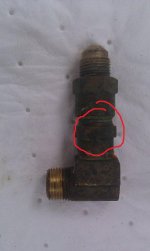I fixed my hestitation and ultimate stalling issue by replacing one of my anti-siphon valves the other day. $14 part, easy fix. This is something that could leave you in a tough spot (i.e., losing an engine when docking or rough weather). This was on my winter "list" last year but just never got around to it.
Ironically, I replied to another post just a couple of weeks ago asking what the work around would be if this failed on the water and then it did
I would strongly recommend changing them on both tanks at your leisure. That's what I did and have another new spare on board. For me, I also hit the bonus round. I've been half heartedly chasing my lack of WOT RPM's throughout the season. I was getting maybe 3,600. After changing the valve on my Stb side, I could immediately feel the difference in the slip. Sure enough, I climbed over 4,000 during my test run... the first time it's done that since I bought the boat.
I think these might actually be a wear item. Probably not from use but from dirt accumulating over the years. If you're experiencing any of the above symptoms, put in a new valve(s). It's a good thing to do anyway...
Bob
P.S. - the "valve" really doesn't look like much. It just a brass fitting sandwiched between the fittings on the tank/line. If you need 3/8" NPT x 3/8" the only place I found them was through Silverton parts. (I have a Trojan).
Ironically, I replied to another post just a couple of weeks ago asking what the work around would be if this failed on the water and then it did
I would strongly recommend changing them on both tanks at your leisure. That's what I did and have another new spare on board. For me, I also hit the bonus round. I've been half heartedly chasing my lack of WOT RPM's throughout the season. I was getting maybe 3,600. After changing the valve on my Stb side, I could immediately feel the difference in the slip. Sure enough, I climbed over 4,000 during my test run... the first time it's done that since I bought the boat.
I think these might actually be a wear item. Probably not from use but from dirt accumulating over the years. If you're experiencing any of the above symptoms, put in a new valve(s). It's a good thing to do anyway...
Bob
P.S. - the "valve" really doesn't look like much. It just a brass fitting sandwiched between the fittings on the tank/line. If you need 3/8" NPT x 3/8" the only place I found them was through Silverton parts. (I have a Trojan).


